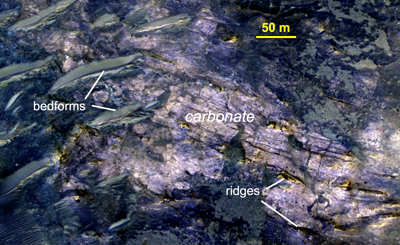Source: Journal of Geophysical Research: Planets
The search for life on Mars has been fueled by findings that suggest the Red Planet may have once been a wet one, with ancient lakes, rivers, and oceans flowing over its surface. Where there is water, there can be life, if Earth is any example. Scientists believe that if water did once flow on the surface of Mars, the planet’s bedrock should be full of carbonates—minerals that would have formed when paleoatmospheric carbon dioxide was trapped in ancient surface waters. Such minerals could provide further evidence that Mars was once host to habitable, watery environments, but researchers have struggled to find physical evidence for a carbonate-rich bedrock.

Now Wray et al. provide new evidence for the existence of buried deposits of iron- and calcium-rich Martian carbonates. The researchers identified carbonates on the planet with the Compact Reconnaissance Imaging Spectrometer for Mars (CRISM) aboard the Mars Reconnaissance Orbiter. The tool picks up on the unique spectral signatures carbonate ions give off during vibrational transitions. The team paired CRISM data with images from the High Resolution Imaging Science Experiment (HiRISE) and Context Camera (CTX) on the orbiter and the Mars Orbiter Laser Altimeter (MOLA) on the Mars Global Surveyor to gain insights into the geologic features associated with carbonate-bearing rocks.
The researchers detected iron- and calcium-rich carbonate-bearing rocks in the Huygens basin, a basin greater than 450 kilometers wide that is rimmed with impact craters and troughs that expose ancient, subsurface materials. The widespread detection of carbonate-bearing rocks in the basin suggests that at least regionally, conditions were once suitable for carbonate formation.
The strong carbonate signals in impact craters such as the Lucaya crater suggest that the minerals may have been previously buried up to 5 kilometers below the surface in ancient rock more than 3.8 gigayears old. Thus, they represent a window into a time when the climate on Mars was very different than today. The depth and age of these rocks may partially explain why researchers failed to find large areas of carbonate-loaded bedrock in the past. Without a plate tectonic system like that of Earth to push buried materials to the surface, impacts may be one of the only ways to excavate deposits of carbonate-rich rocks.
The global distribution of Martian carbonates has yet to be resolved. Still, the authors note, the ancient carbonates could serve as a point of comparison for organics found on Mars in order to identify biosignatures of ancient life on the Red Planet. (Journal of Geophysical Research: Planets, doi:10.1002/2015JE004972, 2016)
—Kate Wheeling, Freelance Writer
Correction, 3 May 2016: An earlier version of the picture of aeolian bed forms taken by HiRISE incorrectly included a scale bar in miles instead of meters. This error has now been fixed.
Citation: Wheeling, K. (2016), Martian carbonates spotted by the Orbiter, Eos, 97, doi:10.1029/2016EO051551. Published on 3 May 2016.
Text © 2016. The authors. CC BY-NC-ND 3.0
Except where otherwise noted, images are subject to copyright. Any reuse without express permission from the copyright owner is prohibited.

